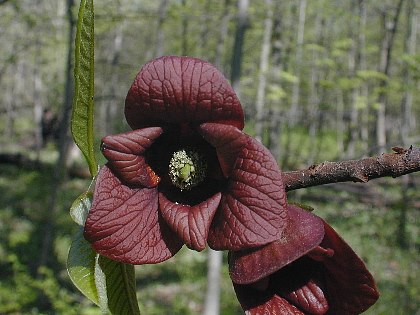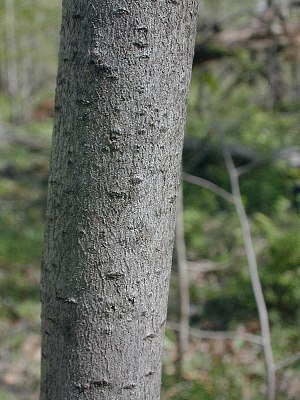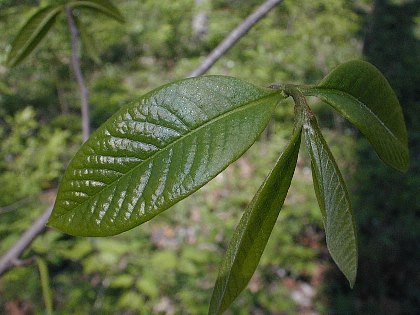Description: This is a shrub or small tree about 6-30' tall that branches sparingly (especially in shaded areas). The trunk and larger branches are covered with a thin bark that is light gray and speckled from small lenticels (air pores). Twigs and smaller branches are more brown and smooth. The alternate leaves are spaced closely together toward the tips of 1st year branches. Mature leaves are 5-12" long and 2-4" across; they are oblanceolate to obovate and smooth along the margins. The upper surface of each leaf is medium to dark green and glabrous, while the lower surface is light green and pubescent (at least while young); the bottom of the leaf is wedge-shaped, while its tip is usually blunt.

Individual reddish
brown flowers develop on 2nd year branches. Each flower nods downward
from a short stout pedicel about ½" long; this pedicel is green to
brownish green and densely covered with fine brown hairs. The typical
flower spans about 1½" across, consisting of 3 sepals, 3 outer petals,
3 inner petals, numerous cream-colored or pale yellow stamens, and
several green ovaries and their styles. The sepals are broadly ovate,
light green, and pubescent; they are much shorter than the petals. Both
the outer and inner petals are reddish brown at maturity (but green
when immature), leathery in texture, and wrinkled from numerous veins.
The outer petals are oval in shape, while the inner petals are
oval-deltoid and smaller in size than the former. Both types of petals
spread outward to expose the reproductive organs of the flower. The
blooming period occurs during mid- to late spring and lasts about a
month. The flowers have a slightly fetid scent. Each fertile flower
produces a cluster of hanging edible fruits (technically, berries);
these fruits become ripe during the fall. Each fruit is about 3-6"
long, 1–1½" across, and oblongoid in shape; the skin of immature fruit
is green, while the skin of mature fruit is yellowish green to pale
yellow. The interior of each fruit is fleshy with a flavor that
resembles custard, banana, or papaya; each fruit has two rows of seeds
toward its center. The large seeds are orange-brown to brown with a
smooth surface, ovoid, and somewhat flattened; each seed spans ½–¾"
across. The root system consists of a woody taproot and underground runners; the latter can
produce vegetative offsets. Pawpaw occasionally forms small colonies of
woody plants.
runners; the latter can
produce vegetative offsets. Pawpaw occasionally forms small colonies of
woody plants.
Cultivation:
The preference is light shade to partial sun, moist to mesic
conditions, and a fertile loamy soil with sufficient organic matter to
retain moisture. Older plants that are larger in size can tolerate more
sun. Locations with standing water or excessive dryness should be
avoided. There are few problems with pests and disease. Germination of
the seeds requires a period of 90-120 days of cool moist stratification.
Range & Habitat:
The native Pawpaw is common in southern and central Illinois, but it is
uncommon
or absent in northern Illinois (particularly in the NW section of the
state; see Distribution
Map). Illinois lies along the northern range limit of this
woody species. Habitats include moist to mesic deciduous woodlands and
small woodland openings. Pawpaw is an understory tree/shrub in
Maple-Basswood and Maple-Beech woodlands. It can often be found in the
vicinity of fallen trees, where there is more light. Sometimes Pawpaw
is cultivated for its unusual foliage and fruit.
Faunal Associations:
The flowers attract flesh flies (Sarcophagidae), blow flies
(Calliphoridae), and other flies; this is because the color of the
flower petals and the floral scent resemble rotting carrion. Flies suck
nectar from the flowers and may feed on the pollen. It possible that
carrion beetles are also attracted to flowers, but this remains to be
substantiated. In Illinois and other northern states, the caterpillars
of the butterfly Eurytides marcellus (Zebra
Swallowtail) and the moth Dolba hyloeus (Pawpaw
Sphinx) feed exclusively on the leaves of Pawpaw. The large edible
fruit is a popular food source of Raccoons and Opossums; it is also
eaten by the Red Fox, Gray Fox, Striped Skunk, Gray Squirrel, Fox
Squirrel, and Woodland Box Turtle. These animals spread the seeds to
new locations. Some birds may also peck at the fruits, but they are
less likely to distribute the seeds. White-Tailed Deer and other hoofed
herbivores don't browse on the leaves because of their odor and
toxicity.
Photographic Location:
A mesic deciduous woodland at Busey Woods in Urbana, Illinois.

Comments: Pawpaw is the only member of the Custard Apple family in Illinois, which consists primarily of tropical and subtropical species. People have mixed reactions when they taste the wild fruit of Pawpaw – some people say they like it, while others find it repugnant. However, there are several cultivars of Pawpaw that have been selected to produce better-tasting fruit; these cultivars can be purchased from various nurseries. In order to produce fruits, the flowers of Pawpaw have to be cross-pollinated from genetically distinct plants. Because pollinating insects tend to be scarce during the spring and flies aren't the most reliable pollinators, such cross-pollination doesn't necessarily happen. To stimulate the development of more fruits, it is possible to cross-pollinate by hand the flowers that are within one's reach. The leaves of Pawpaw contain a powerful insecticide that may be of commercial importance – this is probably the reason why it is bothered by few insect pests. The leaves also contain a chemical with promising anti-carcinogenic properties. The common name is derived from an Arawak word for 'papaya' fruit, which resembles the fruit of Pawpaw somewhat. Because of its odd flowers, the tropical appearance of its leaves, and its large fruits, Pawpaw is easy to identify in the field.